The First and Last
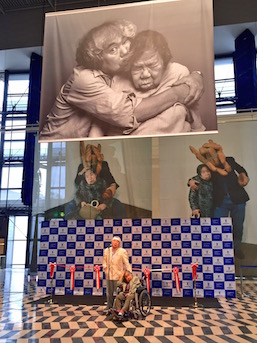
Tatsumi Orimoto’s “Art x Life” at the Kawasaki City Museum comprises videos, drawings, posters, sculptures, photographs and newspapers spanning his career. The exhibition occupies two wings of the museum, with the central hall between hung with large fabric prints of the artist and his mother. Throughout artworks are accompanied by documentation and archival material, communicating a sense of Orimoto’s biography, methods and ideas, the interlacing of which is summarized by the exhibition title.
Kawasaki is Orimoto’s hometown and much of the work on display was produced there and concerns issues pertinent to the area. The exhibition begins with selections from the ‘Art Mama’ series, which focuses on Orimoto’s care for his elderly mother, who suffers from both Alzheimer’s Disease and deafness. Care issues are of growing relevance in Japan, where now almost one hundred eighty thousand people between 15-29 years old tend to a family member. With government projections showing that by 2055 around 40% of Japanese citizens will be sixty-five or over, homecare is an increasingly common lifestyle. Orimoto conveys the complexities and emotional difficulties connected to this demographic through absurd, dark and humorous performances and events.
The video Beethoven Mama is a particularly vivid introduction to his work. Here Orimoto plays with the hair of his seated ninety-three year old mother while singing along to Beethoven’s Symphony No. 5. He has placed himself in the position of the conductor, and alludes to being the conductor of another’s life – dictating his mother’s routines and actions. Like Orimoto’s mother, Beethoven was deaf and significantly ill at the end of his life.
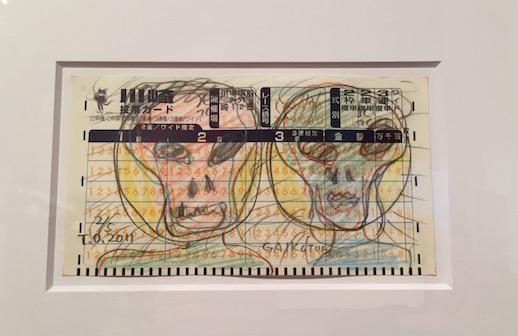
A related video, Elvis Presley – Changing Diapers, has Orimoto replacing his mother’s diaper wearing an Elvis mask and listening to the King’s music. The playlist begins with That’s Alright (Mama). With resolute black humor, Orimoto wears the happy mask throughout his action. There is poignancy to be found in his careful gestures, but this stands in troubling contrast to the surreal imposition of pop culture into sad domesticity.
The darkness continues in Gaikotsu – Skull. This series of drawings was made on the backs of betting slips at Orimoto’s local Kawasaki stand bar. Each day while his mother is cared for by home-helpers, Orimoto has an hour to himself and escapes for a drink and a flutter. The five hundred slips are a testament to Orimoto’s trapped routine and somber thoughts in Kawasaki’s lonely underbelly.
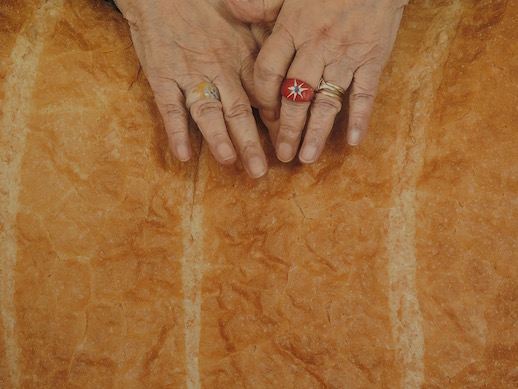
In contrast to this material is the Grandmother’s Lunch project, in which Orimoto brings together a community – often an overtly excluded one, such as the invitees of 50 Japanese Immigrant Grandmothers. The biggest of these gatherings was held in Evora, Portugal in 2014 for 500 Grandmothers – Lunch. In video documentation, Orimoto sings with locals and serves soup in a large and noisy hall. It is a statement for community, conversation and care.
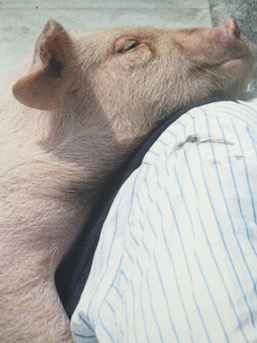
Orimoto’s animal performances, an important body of work, are also surveyed in the exhibition. Orimoto lived in New York between 1971-1979, where the interdisciplinary events of the Fluxus Movement were formative experiences. At Rene Block Gallery he witnessed Joseph Beuys’ 1974 work I Like America and America Likes Me, in which for three days Beuys spent his daylight hours in a room with a coyote.
Orimoto’s own animal performances invoke a similar tension between nature and culture. In Carrying a Baby Pig on My Back, he resembles the comic father to a cute but difficult piglet he has strapped to himself in a baby carrier. Associating care and responsibility with holding a burden, Orimoto resembles a strange Atlas, shouldering not a globe but a swine.
A compelling feature of the show is a recreation of Orimoto’s busy studio, a small room packed with documents, photographs and posters. In the next wing, walls of drawings are hung salon-style in geometric blocks. A series of dense watercolors, in predominately red, yellow and green completed from 1997-2004 portray rooms of figures in the middle of various exertions (sexual, labor, domestic), and provide insight into the underpinnings of Orimoto’s work. As in his performances there is an emphasis placed on the actions of the body.
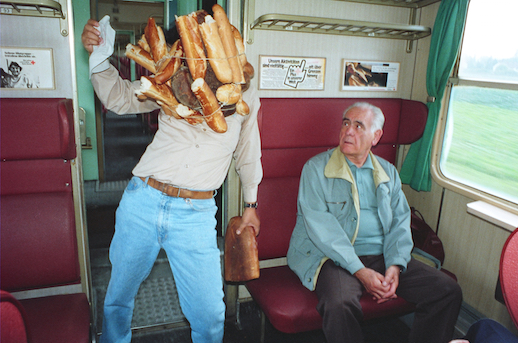
In documentation of Orimoto’s Breadman performances, the artist ties bread around his head, concealing his face in crust, flour and seeds. There is a Christian undertone to the work, as Orimoto appears halfway through an act of transubstantiation – half man, half bread. A clown and king, crowned with baguettes.
These performances take place in Nepal, Germany and Brazil, amongst other places. While bread is a global foodstuff, the varied performances elicit different reactions, which allude to the cultural, economic and social particularities of place. Breadman in the Train has Orimoto in Germany as an immigrant or tourist – badly equipped, anonymous and almost blind. In these performances he is a sad outsider figure, who garners confusion, pathos and laughter from his public.
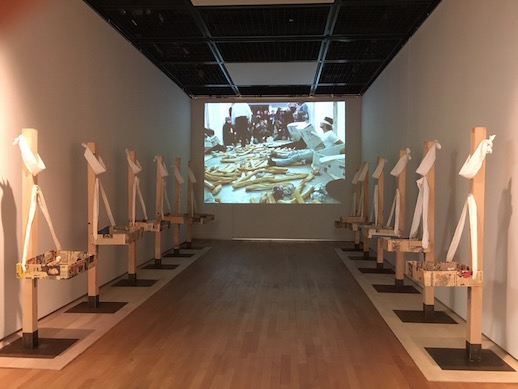
The solitary and cartooned figure, often under duress, recurs throughout the exhibition. It reaches an intense climax in a series of performances called Punishment. Here various people stand bound to wooden poles, their heads covered in white bags and baskets of bread tied to them. The figures struggle, yell and fall, spilling bread from their merchant baskets. They are together, but separated by their collective blindness. It is perhaps only their shouting that alerts the others around them to their shared condition. As Jacques Rancière comments in the book Moments Politiques: Interventions 1977-2009, “There is no truth in suffering except that which emerges through a dramatization that gives it speech, an argument.”
Calum Sutherland
Calum Sutherland



